There is something fascinating in the symmetry and contrast provided by white wings on a black bird. Some species even sport splashes of color on their heads, bodies, or tails.
Whether you want to learn more about black and white avifauna or add some species to your birdwatch bucket list, the thirty species of black birds with white wings below are truly stunning:
- White-winged tern
- Black vulture
- White-winged blackbird
- White-winged chough
- Northern mockingbird
- Swallow-tailed kite
- White-winged scoter
- Eurasian magpie
- Black oystercatcher
- California condor
- Turkey vulture
- Golden eagle
- White-winged robin
- White-winged widowbird
- Common black hawk
- Common loon
- Tufted duck
- White-winged black-tit
- Black guillemot
- Rose-breasted grosbeak
- Carnaby cockatoo
- Yellow-headed blackbird
- Crested myna
- Bobolink
- Tricolored blackbird
- Australian pied oystercatcher
- Little pied cormorant
- Ivory-billed woodpecker
- Anhinga
- White-winged cotinga
Note: This is not an exhaustive list, and the birds are not ranked in any particular order.

1. White-Winged Tern

Scientific name: Chlidonias leucopterus
Perhaps the perfect example of white-winged black bird, the white-winged tern is the Eurasian counterpart of the common black tern in North America.
This small bird is typically found from Central Europe to Central Asia, but rare sightings have also been recorded in North America, where vagrant white-winged terns can sometimes be seen from the Great Lakes to the north Atlantic Coast.
This bird has a black body and white-gray wings, back, and tail. The black tern is almost identical, but its wings, back, and tails are a darker gray.
2. Black Vulture

Scientific name: Coragyps atratus
A black raptor with white wings, the black vulture appears all black when seen with its wings folded. However, the inner primaries are white, giving this bird a majestic appearance during flight.
Black vultures also have whitish feathers under the chin and on the necks.
Like most vultures, the black vulture is predominantly a scavenger. It is a common black bird with white wings on the East Coast, its range expanding south to Arizona and Central America.
3. White-Winged Blackbird

Scientific name: Calamospiza melanocorys
One of the most common black birds with white wings in Colorado – so common that it was designated the state bird – is the white-winged blackbird, which is actually a lark called lark bunting.
Adult males of this species have velvety black plumage with white wing coverts. They also have white edges on the tertial flight feathers.
Females and juveniles are duller, typically a buff brown with black strikes on the wings. Both males and females have whitish-gray beaks.
The lark bunting is evenly distributed across the central United States, its territory expanding to Canada to the north and into Mexico to the south.
4. White-Winged Chough

Scientific name: Corcorax melanorhamphos
Often confused with crows and ravens, the white-winged chough is a black bird with white wings native to Australia – even though it can look like a messenger of the underworld when its wings are folded.
In fact, this bird is almost completely black, except for two white patches that are only visible when the chough spreads its wings. The red eyes also contribute to giving it an eerie appearance.
White-winged choughs are one of the two surviving members of Australian mud-nest builders, and it can be found in open woodlands and forests in eastern and southeastern mainland Australia, except for the Queensland area.
5. Northern Mockingbird

Scientific name: Mimus polyglottos
Found across North America in every kind of habitat, the northern mockingbird isn’t exactly black, but its dark gray plumage on the back often looks like a faded black.
The wings aren’t entirely white either, but they have white stripes on the second and third rows of flying feathers. A thicker white stripe is visible underneath.
Commonly described as a medium-black bird with white stripes on its wings, the northern mockingbird is also found in northern Mexico, the Bahamas, the Greater Antilles, and the Cayman Islands.
Moreover, it has been introduced and established in Hawaii.
6. Swallow-Tailed Kite

Scientific name: Elanoides forficatus
The swallow-tailed kite is a beautiful black bird of prey with white wings common from the southern United States to eastern Peru and northern Argentina.
What makes this raptor special is the distribution of colors. The bird has a white head and neck, but it is black on the back.
The entire underside is white except for the first row of flying feathers that are black on both sides.
This color distribution gives the kite an interesting look during flight. From below, it looks like a white bird surrounded by a black halo.
7. White-Winged Scoter

Scientific name: Melanitta deglandi
A black duck with white wings and the largest scoter, the white-winged scoter typically breeds in the northernmost parts of North America, including western Canada and Alaska.
This migratory duck mostly feeds on mollusks, aquatic insects, and crustaceans found in fresh and saltwater alike. Wintering typically happens along America’s Atlantic and Pacific coasts.
Adult males are almost completely black and have a distinctive white patch on the wings. Juveniles and females are usually duller, their color ranging from brown to dark chocolate.
Both males and females have small white marks under the eyes.
8. Eurasian Magpie

Scientific name: Pica pica
The Eurasian magpie is best described as a black and white bird with white wings – even though the wings are tipped with black and streaked with blue, green, or purple.
One of the most common magpie species in Eurasia, this mid-sized corvid is heavily distributed throughout Europe.
It is considered one of the most intelligent birds, their brain-to-body mass ratio being outmatched only by humans and the great apes.
This explains their ability to use tools, work in teams, play games, imitate human speech, and even grieve.
9. Black Oystercatcher

Scientific name: Haematopus bachmani
The black oystercatcher is one of the most common black seabirds with white wings on the West Coast.
Its geographic range stretches from Alaska southward, all the way to Baja California.
These birds are essentially black with pink feet and red-orange beaks. However, they have distinctive white patches on the first row of flying feathers that are visible when the wings are spread.
Black oysters are non-migratory and mostly feed on mussels and limpets – a dietary habit that earned them their name.
10. California Condor

Scientific name: Gymnogyps californianus
The California condor is the largest North American land bird, as well as one of the largest black birds with white wings in California.
However, sightings are very rare. This species used to thrive in the southern United States and Mexico, but it became near extinct in the 1980s when only 23 individuals were left in the wild.
Conservation efforts paid off, and the bird was slowly reintroduced to wild habitats. However, according to IUCN, the population only counts about 200 adult individuals.
11. Turkey Vulture
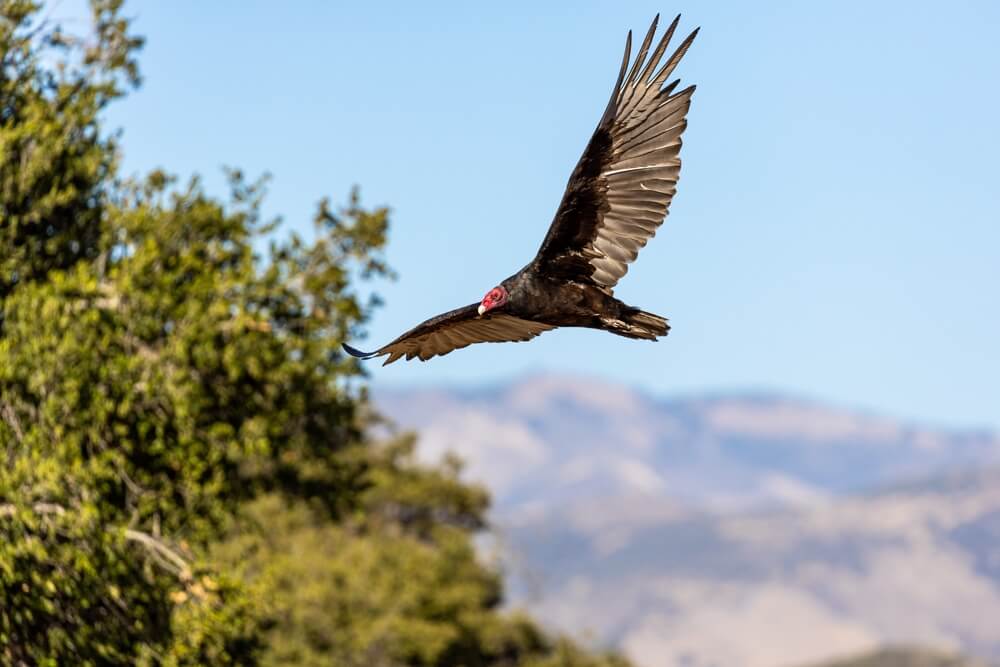
Scientific name: Cathartes aura
Often described as a brown bird with white spots on the wings, the turkey vulture is actually covered in black plumage on the head and body.
Its wings are lighter in color, their hue ranging from brown to dark chocolate. All wing feathers have white tips on top. However, the first row of flying feathers is completely white beneath, while the second row is a grayish-white color.
Like most vultures, the turkey vulture is predominantly a scavenger and has a bald red head.
This raptor lives year-round in the southern United States. Northern populations are typically migratory.
12. Golden Eagle (Juvenile)

Scientific name: Aquila chrysaetos
About the same size as the bald eagle, the golden eagle is a common raptor in North America, Europe, and Asia.
Adults have light brown feathers that could look golden in the sunlight; hence, the bird’s name. However, golden eagle juveniles are black raptors with white wing patches.
They also have bicolored tails with a white base and black terminal band.
13. White-Winged Robin

Scientific name: Peneothello sigillata
A category of small black birds with white wings, the white-winged robins are a species of passerine birds common in New Guinea’s highlands, as well as the country’s subtropical and tropical moist mountain forests.
These forests have thick canopies, and the bird’s coloration is most likely an environmental adaptation, enabling the robins to camouflage themselves. As insectivores, camouflaging is usually essential when foraging.
Male and female white-winged robins are identical. They have true black bodies, black legs, and black beaks. Their wings are largely white, and their eyes are dark brown.
14. White-Winged Widowbird

Scientific name: Euplectes albonotatus
Another species of passerine bird, the white-winged widowbird is a small black bird with white and yellow wings in Africa.
It occurs in southern Tanzania and is completely black except for one white and one yellow stripe on each wing.
The legs are black, but the white beak complements the dark plumage and matches the white patches on the wings.
15. Common Black Hawk
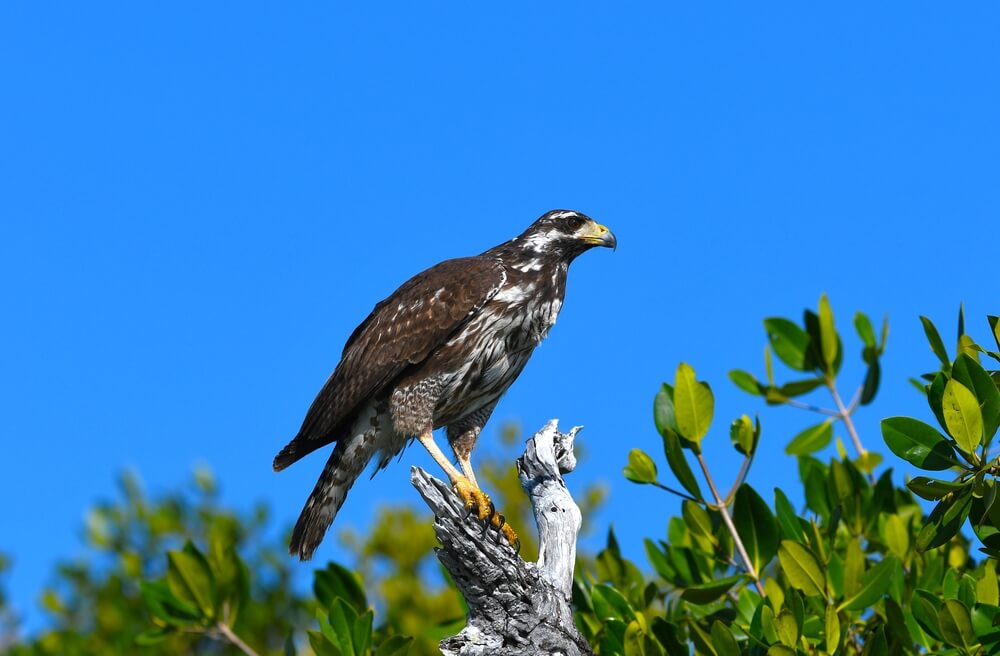
Scientific name: Buteogallus anthracinus
A hawk with white wing tips – even if only visible when the wings are spread – is the common black hawk native to the Americas.
This bulky raptor is found in open woodlands or agricultural fields near water sources. Its typical range is tropical America, even though it breeds in the United States as well, in New Mexico and Arizona.
Common black hawks typically breed in tall trees and feed on fish, frogs, and other small creatures. In the tropical Americas, they can be found in a variety of habitats.
16. Common Loon
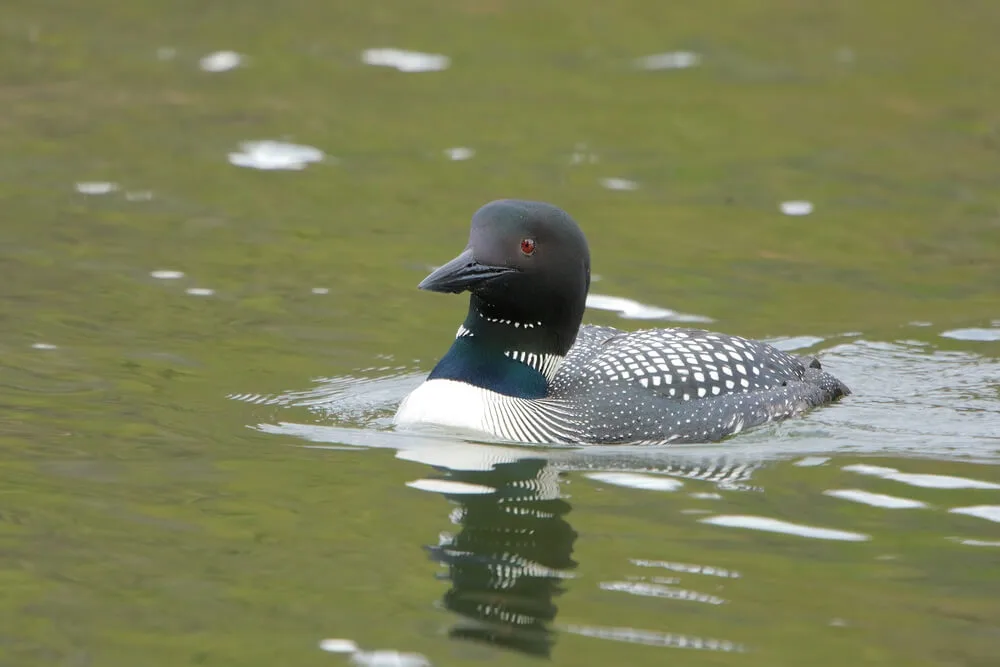
Scientific name: Gavia immer
The most abundant loon species in North America, the common loon is a large black bird with white spotted wings.
This migratory waterfowl species is typically found in Canada and Alaska during the breeding season, its range expanding into the northern USA. It winters further south, in the southern United States and Baja California.
Its plumage isn’t black all year round.
However, during the breeding season, it has a black head with a black and white striped collar at the back of the neck and checkered black and white wings that give off an absolutely stunning pattern.
These loons have white bellies and chests.
17. Tufted Duck

Scientific name: Aythya fuligula
Aptly named for the tuft of black feathers adorning its head, the tufted duck is another type of black waterfowl with white wings.
This bird found in northern Eurasia has black upper sides and a black chest. The wings are black on top but white underneath. The belly and sides are also white.
When spread out, the wings display a gorgeous first row of flying feathers that is white on both sides. If seen from above during flight, the duck looks black with white wing stripes. Females are usually brown.
In addition to being a black duck with white wings, the tufted duck is also one of the few species of ducks with blue bills.
18. White Winged Black-Tit

Scientific name: Parus leucomelas
A type of passerine, this small black bird with white wing tips, is a non-migratory species found in central Africa, from Angola to Ethiopia.
The bird has slightly iridescent black plumage all over its body, except for the wings that have a white outer side and white tip.
A similar species is the white-bellied tit that has similar coloring but presents white undersides and has whiter wings.
19. Black Guillemot

Scientific name: Cepphus grylle
A mid-sized black bird with white wings, the black guillemot is a seabird native to the northern Atlantic coast and eastern North American coast.
Its breeding plumage is entirely black, except for visible white patches on each wing. The beak is also black, but these birds have red legs and feet.
The black guillemot is often mistaken for the common murre, which is another seabird native to the boreal waters in the North Atlantic.
Indeed, these two birds look similar, but the common murre has white undersides, and its wings are black on the upper side.
20. Rose-Breasted Grosbeak

Scientific name: Pheucticus ludovicianus
One of the most beautiful birds in the cardinal family, the rose-breasted grosbeak, has a black and white body with a splash of red on its chest.
The upper sides, including the head, back, and wings, are black with white patches towards the tail and on the wings.
The underside is white except for the chest, which presents a brilliant red chevron. They also have pink-red stripes under the wings.
Females and juveniles are heavily streaked brown. Both males and females have sturdy beaks.
Rose-breasted grosbeaks are native to the Americas, breeding in eastern North America and moving to tropical areas in winter. They are one of the black birds with white wings in Tennessee.
21. Carnaby’s Cockatoo

Scientific name: Calyptorhynchus latirostris
Cockatoo parrots are typically known for their rainbow-colored plumage, but black parrots with white wings also exist. The Carnaby’s black cockatoo is one of them, a species native to southeast Australia.
Classified as endangered, this parrot has dull black plumage with narrow off-white fringes on the feathers that give it a scaly appearance.
A white beak, white cheeks, and a white patch at the tail base are some of the bird’s distinctive marks.
Two similar cockatoos are the Baudin’s black cockatoo, which has a shorter beak, and the red-tailed black cockatoo, which has red rather than white panels on the tail.
22. Yellow-Headed Blackbird

Scientific name: Xanthocephalus xanthocephalus
A yellow and black bird with white wings, the yellow-headed blackbird is a passerine related to the common grackle and brewer’s blackbird.
It can be found all over the USA, even though it is only present in most areas during the breeding season. Permanent populations occur in California and Arizona.
Yellow-headed blackbirds can be spotted during the summer in many other states, but they typically winter in Mexico or South America.
These omnivore songbirds are characterized by their bright yellow heads that contrast with the deep black plumage on their bodies. The wings are also black, but they have white patches visible during flight.
23. Crested Myna

Scientific name: Acridotheres cristatellus
Also known as the Chinese starling, the crested myna is one of the black birds with white wings in Asia.
It is typically found in open spaces near urban and agricultural areas, although they can also be spotted in open forests and woodlands. The geographic range expands all the way from China to Indochina.
Named for the tuft of feathers at the base of their beaks, crested mynas are mostly black. The iridescent plumage has a green sheen, while the primary flight feathers and the tips of the tail feathers are white.
24. Bobolink

Scientific name: Dolichonyx oryzivorus
One of the most common black birds with white wings in Oregon, the bobolink is a peculiar-looking New World blackbird.
The main difference between this species and other blackbirds is the mostly white upper side with black strikes.
Bobolink wings are largely black and white, while the undersides are almost entirely black.
25. Tricolored Blackbird

Scientific name: Agelaius tricolor
Another type of blackbird with white wings, the tricolored blackbird, is a member of the Icteridae family but it only occurs in a very limited range – confined between California and Baja California.
This passerine is very similar in appearance to the white-winged blackbird, the main difference being the red shoulder patches that flank the white on the wings.
26. Australian Pied Oystercatcher

Scientific name: Haematopus longirostris
Commonly found on the Australian coastline, the Australian pied oystercatcher is very similar to the black oystercatcher, but its underside is mostly white rather than black. The chest is black, though.
When folded, the wings look black. However, the white second flight feathers are clearly visible when the wings are spread or during flight.
Like most oystercatchers, these birds have pink-red feet, red eyes, and bright orange beaks. Pied oystercatchers are some of the most common black birds with white wings in Western Australia.
27. Little Pied Cormorant

Scientific name: Microcarbo melanoleucos
One of the smallest black cormorants with white wings, the little pied cormorants are mostly black in color with white patches on the underside. The size of these patches varies from species to species.
The most commonly known type has a completely white underside. However, the M.m. brevicauda subspecies found in New Zealand is almost entirely black with a small white patch that goes from under the chin to the eyes.
All little pied cormorants also have random white splashes on the upper side of the wings.
28. Ivory-Billed Woodpecker

Scientific name: Campephilus principalis
A very rare black bird with white wings in the temperate United States is the ivory-billed woodpecker.
It typically lives in bottomland hardwood forests and temperate coniferous forests in southern USA; a separate subspecies is native to Cuba.
These are the largest woodpeckers in the United States.
They are characterized by a glossy black plumage that contrasts with the white stripes running from the sides of the head to the base of the wings. Males also have a bright red crest; females have a crest too, but theirs is black.
Ivory-billed woodpeckers are critically endangered, with an estimate of fewer than 50 adult individuals left in the world.
29. Anhinga
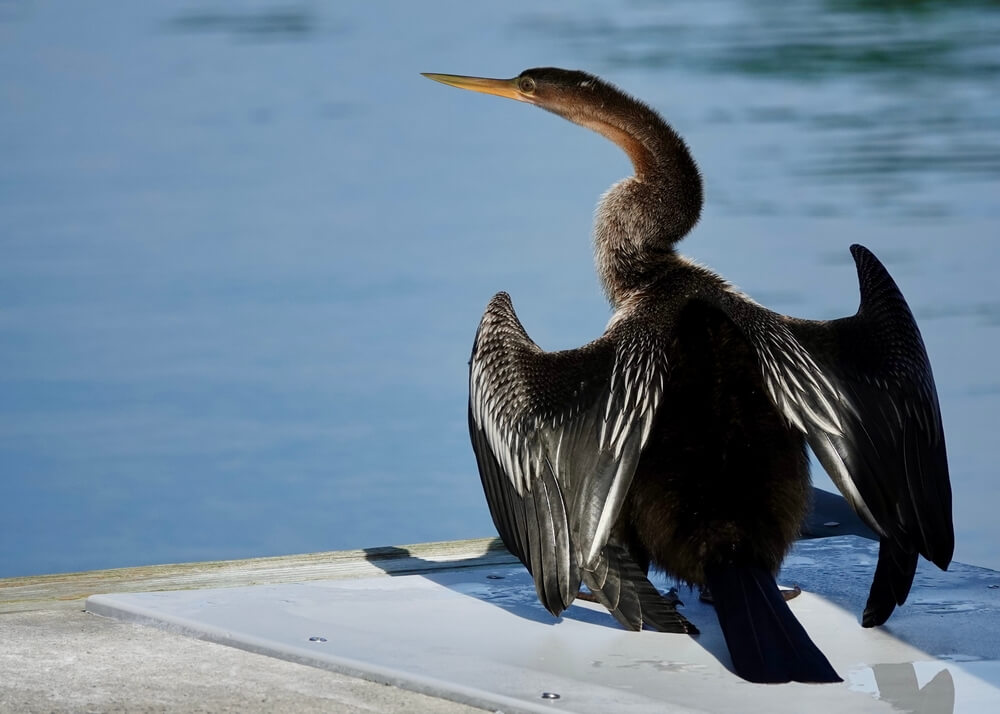
Scientific name: Anhinga anhinga
A black water bird with white wings, the anhinga is found in the warmer parts of the Americas. It is often called snakebird due to its very long neck, which is used to catch fish in fresh bodies of water.
Anhinga birds are almost entirely black, but they have a checkered white pattern and solid white patches on their wings.
They are usually found in quiet areas near swamps or slow-moving rivers, and can breed in northern areas, including New Hampshire.
30. White-Winged Cotinga
Scientific name: Xipholena atropurpurea
Endemic to Brazil, the white-winged cotinga is a tropical black bird with white wings found in the moist lowland forests.
Threatened by the loss of habitat, this is the rarest of the three extant cotinga species. Adult males are almost entirely black.
Their iridescent feathers have a reddish gloss, while the wings are white with dark red feathers at the base. Females are a duller black with white stripes.`

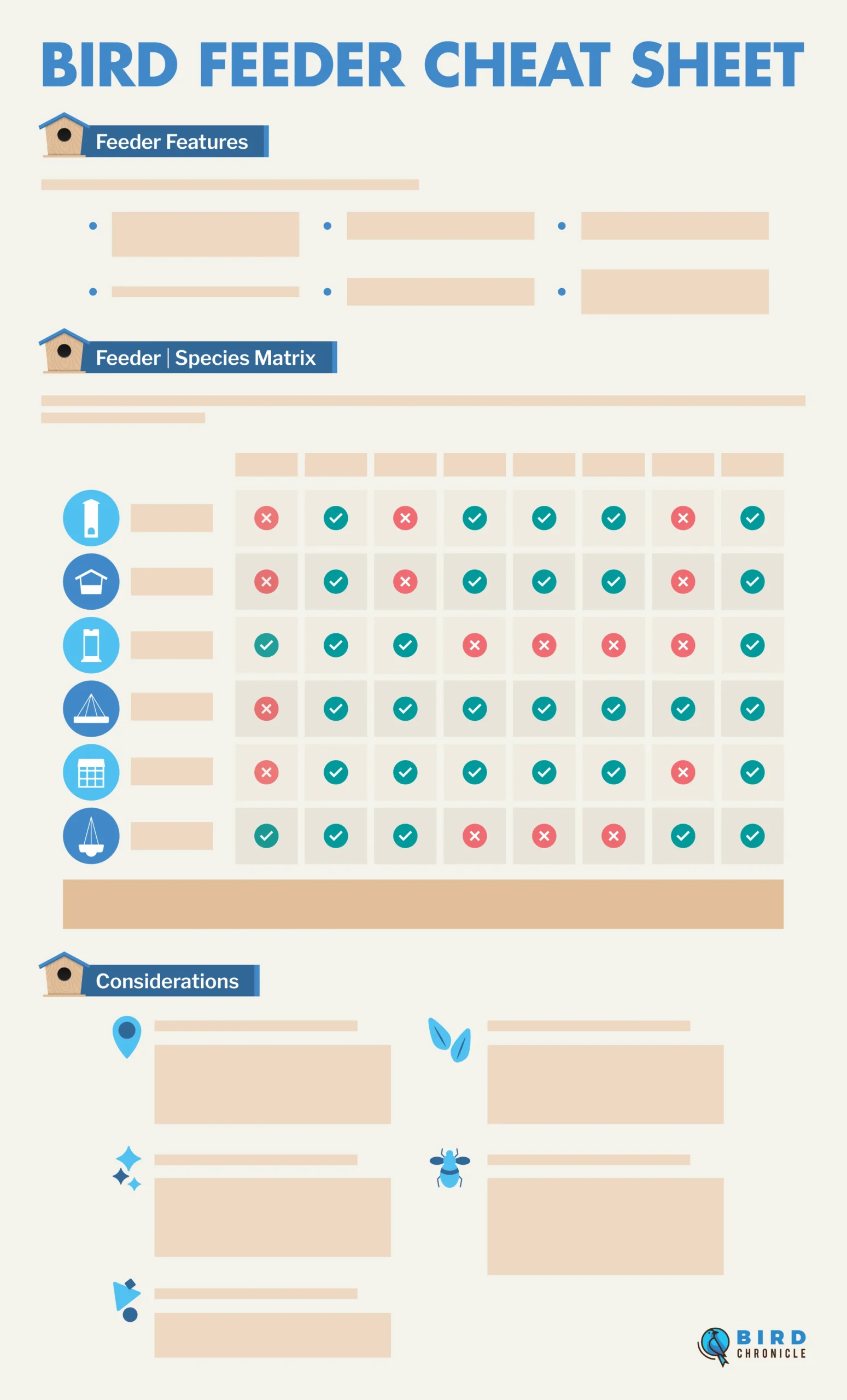




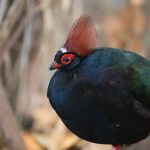
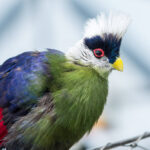
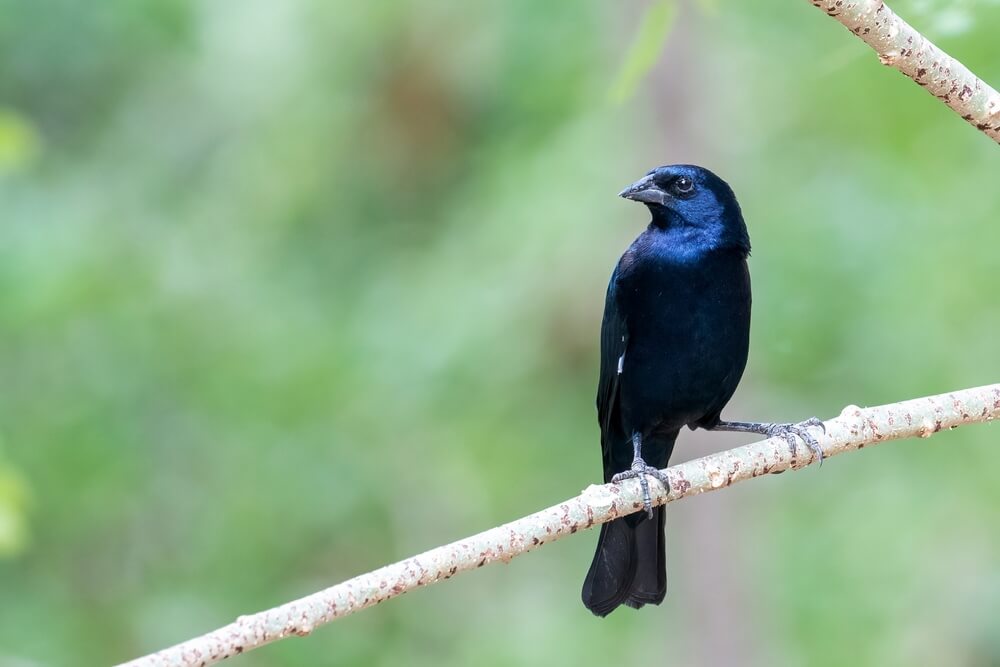
![Bald Eagle Population By State: 2023 Statistics [Data] Bald Eagle Population By State: 2023 Statistics [Data]](https://birdchronicle.com/wp-content/uploads/2023/01/three-bald-eagles-perched-150x150.jpg)

